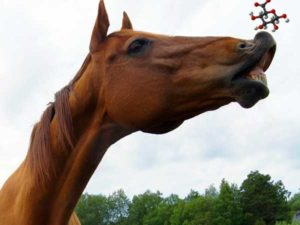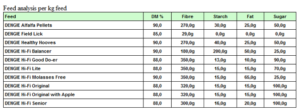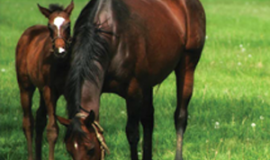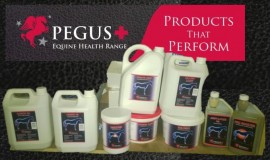Most horses have some type of compound feed included in their daily ration. This is mainly to supply additional energy, protein, vitamins and minerals. Of special interest with horses is the type of feed ingredient providing the energy . It makes a difference if the energy substrate is starch, fat or fibre. Feed manufacturers often have a wide range of compound feeds that vary in composition and nutrient content. Therefore, it is important for the horse owner to be able to make informed choices about the product that best meets the requirements of each horse.
Horses receive their energy from a variety of feed sources. While roughages supply energy mainly from fibre, grains will provide most of their energy from starch. Barley contains about 50% starch while oats contain 35-40%
Fat can be provided as vegetable oils or as high-fat feed ingredients such as rice bran. Oats normally contain about 5% fat, but some varieties contain up to 10% fat. Barley contains about 2% fat.
Starch
Starch (and water soluble sugars) are mainly broken down into glucose by enzymes in the small intestine, and absorbed into the bloodstream. Here, the level of circulating glucose is regulated by insulin. After a starch-rich meal, blood glucose will go up, and insulin secretion will also increase as it regulates and brings blood glucose back to normal. Circulating glucose can be used for direct energy production (if needed) or stored as glycogen in muscle and liver. It can also be stored as body fat.
Some horses are insulin resistant or may have Cushings syndrome. These horses have problems with the regulation of their blood glucose and need a diet that is low in starch and sugars.
The starch content of compound feeds varies from about 15 – 40%.
Fat
Fat can be added to compound feeds as vegetable oils or as other high-fat feed components. The horse will easily digest controlled levels of fat in the ration and amounts up to 0.1 kg fat/100 kg body weight/day are safe to feed. Fat will be absorbed from the small intestine as long-chain fatty acids and used for energy production (if needed) or stored as body fat. Absorption of fat has little influence on insulin production and represents no problem for insulin resistant horses or horses with Cushings syndrome. The fat content of compound feeds can vary from about 2 – 10%.
Fibre
Fibre is digested by the intestinal microbes, mainly in the cecum and colon. This microbial fermentation produces short-chain volatile fatty acids with acetic acid and propionic acid as the most dominant. The volatile fatty acids will be absorbed into the blood stream and utilized for energy production or stored as body fat. Propionic acid can also be used for the production of glucose. Volatile fatty acids are regarded as the most “natural” energy source for horses, and fibre is vital for a healthy gut.
Many compound feeds now have an increased amount of fibre. Fibre can be added as chopped hay, or highly digestible products like beet pulp or apple pulp. The use of highly digestible fibre products makes it possible to keep up the energy content of compound feeds without adding too much starch-rich grains.
The fibre content of compound feeds can vary from about 10 – 20%.
Pegus Horse Feed expert’s uses a fully available list of feed values in our Pegus PC-Horse software .It allows our experts to find the starch, fat and fibre content of all feeds. Pegus Horse Feed experts “Compare nutrient concentrations in feeds”. Selecting the feeds and the nutrients most suitable for your horses insuring that Pegus choose the best products for your horses.
For more information Contact Pegus Horse Feed
www.pegus.ie info@pegus.ie Free Phone Helpline R.O.I.= 1800-378463 UK = 0800 011 4182









